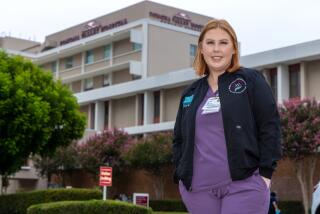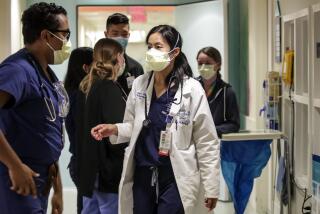Urgent Care : The Number of General Practice Physicians Is in a Virtual Free-Fall, but Nurses With Advanced Training Are Taking on More Responsibilities
- Share via
Chanel Ko does not trust doctors. Not after what happened last year. That is when the 36-year-old dental student went to a Westwood gynecologist to seek treatment for a lingering bacterial infection But two months, a dozen tests and more than $4,000 later--the uninsured Ko’s life savings--her infection was worse than ever.
“I was so upset, I spent my money for nothing,” Ko said. She then followed a recommendation and visited the Westside Women’s Clinic in Santa Monica, where nurses gave her antibiotic that cleared up her infection within a week. Since then, Ko has remained a regular patient of the nurse-staffed clinic, depending on it for routine checkups, medical advice and her birth control needs.
“(Even) if some doctor offered me the same price, I would still come here,” said a still-indignant Ko. “The nurses here are very professional. They see us as an individual.”
Welcome to the brave new world of American health care, and to the medial providers helping usher it in: nurses. No longer just doctors’ assistants relegated to office work and taking blood pressures, advanced-practice nurses today are performing more and more complex medical procedures than ever, supplementing and sometimes supplanting the care of physicians.
The trend, due mainly to a worsening shortage of general practice doctors, is evident on the Westside and throughout Los Angeles. At clinics, HMOs and in private-practice settings, advanced-practice nurses are providing primary care services such as suturing wounds, prescribing drugs, ordering tests, even performing spinal taps and tracheotomies.
At UCLA’s School of Nursing, which because of budget cuts may lose its undergraduate program, officials recently unveiled a special one-year curriculum designed for advanced-degree nurses to deliver primary care.
The UCLA program, scheduled to begin in the summer, will be the only one of its kind offered through the University of California system. School of Nursing officials say they were showered with responses from prospective applicants when they proposed the program, which will train students to become family practice or pediatric nurse practitioners.
The interest appears to be justified. With the Clinton Administration promising to provide health coverage for 35 million to 40 million previously uninsured Americans, experts expect that in the coming decades, nurses will bear an ever-increasing burden of the nation’s primary care needs. Already, says Bonnie Faherty, a UCLA School of Nursing lecturer, the need for nurses is so great there are four jobs for every nurse that graduates.
Statistics tell the story. The type of medical care Americans receive most often is primary care: basic, initial treatment that includes portions of general and internal medicine, family practice, general pediatrics and, in some cases, obstetrical and gynecological care.
Yet the number of physicians practicing general medicine in the United States has been in a freefall for several decades.
Today, barely two of every five physicians practice general medicine, compared with four of five 60 years ago. Projections are that by 2010, only 28% of physicians nationwide will be generalists. Recent medical school surveys indicate that only 14% of students intend to enter general practice upon graduation, an all-time low.
A key reason is economics: Doctors earn far more in specialized practices. According to Medical Economics Magazine, the net income of plastic surgeons in 1991 was $209,840, compared tot he $101,160 of family practitioners and the $86,820 of general practitioners.
“We don’t have a supply of primary care physicians,” said Rick Wade, a senior vice president with the American Hospital Assn. “Even if we turned our medical schools upside down for the next five years, there’s only so many primary care physicians being trained.”
Nurses are in many cases filling the void. At CIGNA HealthCare of California, 40 nurse practitioners staff the HMOs 28 Los Angeles offices. Specializing in pediatrics, adult medicine, and obstetrics and gynecology, they share practices with CIGNA’s 250 primary care physicians. At the HMO’s Fox Hills office, four nurse practitioners provide care to up to 80 patients daily.
Figures provided by the American Nurses Assn., a federation of 205,000 nurses and the nation’s largest nursing organization, illustrate how much nurses can do, and at what cost. According to the organization, between 60% and 80% of the primary care administered by doctorscan be delivered just as well by nurses with advanced training, at a cost of up to 40% less.
Nurses also earn far less than physicians: about $42,000 annually compared to the average doctors’ salary of $170,000. And while there are only 100,000 advanced-practice nurses delivering primary care nationwide--compared to approximately 200,000 general practicedoctors--the ANA says 700,000 more nurses could provide such care with an additional one to two years of training.
“You don’t need as much preparation as physicians have to provide primary care,” Faherty said.
Such assertions, however, are hotly disputed by doctors and the largest organization of physicians, the 300,000-member American Medical Assn. They concede there is a shortage of doctors providing primary care. But they argue that if health care reforms prompt a surge in demand for primary care, specialists will be retrained to help meet it.
Moreover, they question whether advanced-practice nurses can dispense primary care as well as doctors.
“Primary care is not just checking someone’s eyes, ears, nose and throat and giving them a shot,” said Dr. James Seidel, chief of general and emergency pediatrics at Harbor-UCLA Medical Center near Torrance. “It’s a lot of anticipatory guidance and education.”
Nurses, however, insist that their goal is not to operate independently of physicians, but rather to obtain a greater amount of freedom while working with them. Already, in many cases, nurses order tests and perform routine checkups on patients who then see their doctors only perfunctorily.
And while nurses still are not wholly guaranteed the ability to seek reimbursement from insurers, state law allows nurse practitioners and certified nurse midwives to prescribe drugs under certain conditions.
UCLA’s nurse practitioner program is being launched as the highly regarded School of Nursing faces major downsizing in a university-wide cost-cutting effort. The cuts might affect UCLA’s standard two-year nurse practitioner program, university officials say, but not the new curriculum.
Interest in the one-year program has been strong. When they asked nursing students whether they would be interested in the curriculum, UCLA officials received 120 affirmative responses--three times the number of available spaces.
The curriculum, although uniquely designed for advanced-degree nurses-will nevertheless offer a typical nurse practitioner’s training. In the program, 40 students will learn to identify and manage acute and chronic conditions such as cancer, diabetes, hypertension, and respiratory and cardiac problems.
The goal is that eventually they can aid doctors in the direct management of patient care. “Its not that we’re substituting for each other,” Faherty said. “We both have very specific abilities and we’re complementing each other.”
Nurses also contend that they can provide primary care in areas where physicians are reluctant to go. Rural dwellers are used to having advanced-practice nurses substitute for doctors, but inner-city clinics as well are increasingly being staffed by nurses.
In downtown Los Angeles, UCLA’s School of Nursing operates two clinics for the uninsured, undocumented and homeless. On average the two clinics see 75 patients daily. At one clinic in the garment district, the nurses see mostly women and children and provide a large amount of preventive, prenatal and family care.
At the other clinic, on Skid Row, most of the patients are men needing treatment for episodic disease or illness. “Nurses are very interested in providing care to underserved populations,” said Colleen Keenan, assistant professor of nursing at UCLA. “There aren’t any physicians working in those clinics.”
And nurses see a continuing role for themselves in promoting wellness care and health education. Given the prominence recently of health-care cost containment, attention is focusing on preventing illness, which is far cheaper than treating it.
In most cases, small investments in preventive care can reap big benefits. According to ANA Studies, of the $600 million spent on U.S. health care in 1990, less than $18 million was devoted to preventive care. Yet, the same study concluded that every dollar spent on preventive care and education saves four dollars in eventual health care expenditures. “You get bigger bang for your buck with preventive care,” Faherty said.
Such benefits, experts say, will be impossible without nurses actively involved in the delivery of primary care.
“There’s obviously a need for someone to provide these services,” said the AHA’s Rick Wade, who says polls indicate that 60% of Americans would see nurses for their primary care. “There’s going to be a whole new look at what nurses can do.”
Keenan agrees. “A hundred years ago, blood pressure was not taken by nurses because that was practicing medicine,” she said. “Nurses are never going to do neurosurgery, but nurses in collaboration with physicians do lots of medical procedures (now) because we can.”
Disappearing Doctors
General practitioners, the doctors who deliver primary care, are becoming scarce. Increasingly, health-care providers are looking to specially trained nurses to fill the void.
Share of U.S. physicians in general practice:
1931: 87%
1960: 53%
1970: 38%
1988: 33%
Percentage of medical students choosing general practice:
1982: 36%
1988: 22.7%
1992: 14.6%
Average salary for physician (‘91): $170,600
Average salary for nurse practitioner (‘91): $42,600
Sources: American Medical Ass., American Nurses Assn., Assn. of American Medical Colleges, U.S. Public Health Service.






